|

 Up
Up 
 The 1902
The 1902
Wright Glider

(You are here.)
The
1903
Wright
Flyer I

The
1905
Wright
Flyer III




  Need
to Need
to
find your
bearings?
Try
these
navigation aids:
If
this is your first
visit, please stop by:
Something
to share?
Please:



|
|
 uilt in Dayton,
Ohio and test-flown at Kitty Hawk, North Carolina, the original 1902 Wright
Glider is one of the most important machines ever designed. Although the Wright
Brothers are better known for the 1903 Wright Flyer, in which they made the
first sustained powered flights, their 1902 glider was the first fully
controllable aircraft, with movable surfaces that balanced the craft in
the air in all three axes. uilt in Dayton,
Ohio and test-flown at Kitty Hawk, North Carolina, the original 1902 Wright
Glider is one of the most important machines ever designed. Although the Wright
Brothers are better known for the 1903 Wright Flyer, in which they made the
first sustained powered flights, their 1902 glider was the first fully
controllable aircraft, with movable surfaces that balanced the craft in
the air in all three axes.It was also the basis of their
patent. If you look up the Wright brothers patent No. 821,323 for a
"Flying Machine," you'll find drawings of the 1902 Wright Glider,
not a powered aircraft. Putting a motor on an airplane was
nothing new, even in the Wrights' day. What was new, however, was
the manner in which they controlled and navigated their aircraft.
The vertical rudder (at the back of the glider) yawed the nose
from side to side. The horizontal elevator (at the front of the glider) pitched
the nose up and down. And a unique wing-warping system (the forerunner of modern
ailerons) rolled the wings left and right. This allowed a pilot, for the first
time, to navigate in all three dimensions. This basic,
brilliant idea -- yaw, pitch, and roll control -- is still used in every
aircraft flying today. It's also the basis of spacecraft control, submarine
navigation, robotics, computer-aided design and manufacture, and digital
animation. These remarkable advances all trace their roots back
to this simple machine. If you research the fundamental patent on the airplane,
you'll find a drawing of the 1902 Wright Glider, not the 1903 Wright Flyer.
So far, we've built and flown three copies of the
1902 Wright Glider. The particular replica you see in these photographs was built for
our educational
mission. We
designed it to come apart so it will fit through an ordinary door. This allows
us to set up the glider inside a school or museum quickly, easily,
and inexpensively. All we need is a 20' by 40' space and about an hour's time to
assemble the glider. So far, this glider as traveled as far east as Portland,
Maine and as far west as Pasadena, California. We've set it up for the enjoyment
and education of
students from kindergarten to high school. If you would like us to bring this
glider and our "portable museum" of the Wright Brothers to your school
or educational institution, see
"The Secret of Flight" Project.
|
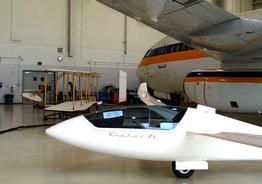
One of the first places we exhibited our 1902 Wright Glider
was at the Purdue University Airport in Lafeyette, IN. It was nestled in between Purdue's Boeing 737 and a
brand new 2002 Grob glider. There was exactly 100 years of
aeronautic progress between the two gliders.
|
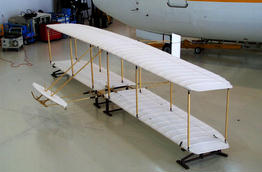
While the Grob represented to pinnacle of the soaring art in 2002,
the 1902 glider was the most advanced aircraft of its day. It was
the first aircraft that the Wright brothers designed using the
scientific data they had gleaned from their wind tunnel experiments,
and the first whose performance they
could predict with certainty.
|
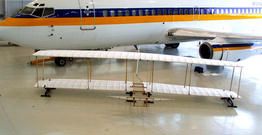
A front view of the 1902 glider. With a
length of 17 feet (5.1 meters) the Wright glider is less than 1/8
the size of the 737. In fact, just the tailspan of the 737 (47 feet/14.3 meters) is 1.5 times the entire wingspan (32 feet/9.7
meters) of the glider.
|
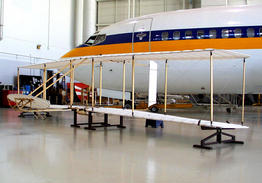
The Wright glider from the left front viewed diagonally.
|
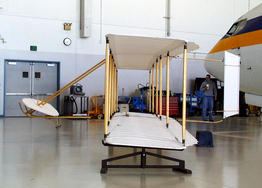
A view of the Wright glider from the left side.
|
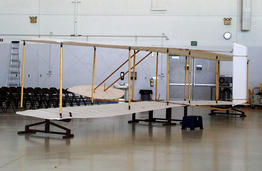
The Wright glider from the left rear diagonally.
|
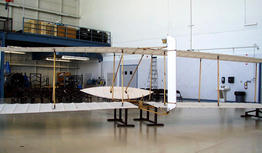
A rear view of the Wright glider.
|
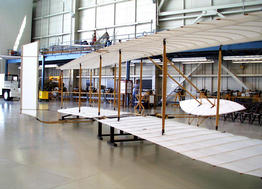
The glider from the right rear diagonally.
|
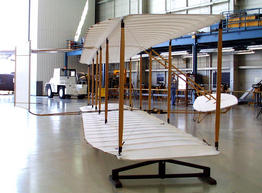
The glider from the right side.
|

A close up view of the glider's front elevator or "canard."
|
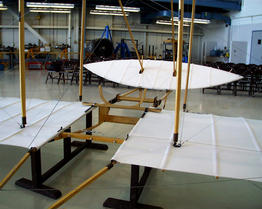
The cockpit of the 1902 Wright glider. The pilot lay prone with his
hips in the U-shaped cradle. By moving his hips left and right, the
pilot warped the wings.
|
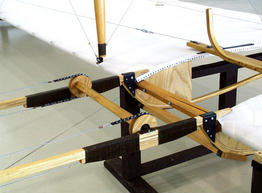
A close-up of the elevator control. The pilot grasped the horizontal
control bar with both hands and rolled his wrists forward or back to
pitch the aircraft nose down or nose up.
|
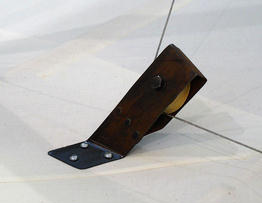
The control wires for the wing warping ran over boxwood pulleys. The
pulleys were turned from roller-skate wheels.
|

A close-up of the strut-to-spar connection. Note the guide for the
control wire.
|
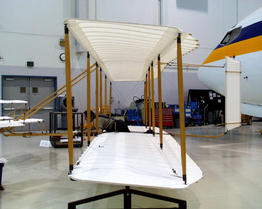
Click on this thumbnail for an animated demonstration of wing
warping.
|

Some things never change. Despite the 100 years that separates the
1902 Wright Glider from the 2002 Grob, they both use the same simple
instrument to gauge the relative wind – a piece of string, called a
"yaw string.". The string is taped to the canopy of the Grob and
tied to the forward rail of the Wright glider.
|
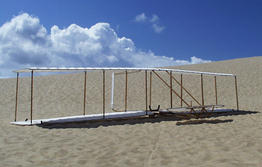
The 1902 Wright Glider on the sand dunes of Jockey's Ridge State
Park in Nags Head, NC. The park is just a few miles south of Kill
Devil Hills on the Outerbanks. The dunes are less than half the size
of those that Orville and Wilbur flew from, but they are nonetheless
the largest undeveloped stretch of dunes remaining in this area.
|
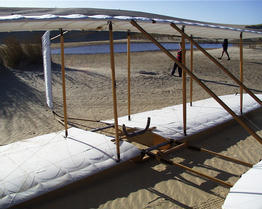
The 1902 glider prepared for flight. Note the horns of the cradle
are wrapped with foam. Not exactly historically correct, but much
appreciated by our pilots. If you suffer through a hard landing
without it, the hardwood cradle badly bruises your hips.
|
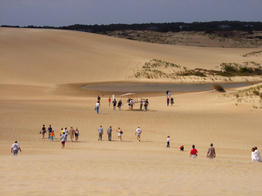
We went to Jockey' s Ridge to celebrate the Centennial of Controlled
Flight. The Wright brothers first flew with three-axis control
(roll, pitch, and yaw) on October 8, 1902 after
modifying their glider to make the rudder movable.
|

Carrying the glider up the dunes. With us on this expedition were
four military pilots and test pilots used to flying much faster
aircraft.
|

We began our test flights the same way the Wrights began -- we kited
the glider to measure its performance.
|

To get ready to fly, the pilot stands in the cockpit space while the
"launchers" pick the glider up. Once off the sand, it immediately
begins to fly in the wind. The pilot is Major Dawne Dunlap USAF, an
F-15 test pilot.
|
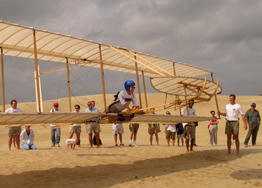
The pilot climbs into the cockpit and the launchers adjust the angle
of attack so the wings best supports the added weight. The pilot is
Captain Tanya Markow, US Army, who is more at home in an Apache
helicopter.
|
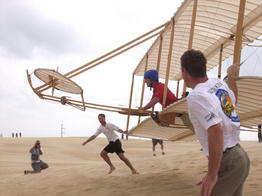
The launchers begin to run the glider into the wind. The pilot is
WBAC member Dudley Mead, an accomplished hang glider pilot.
|
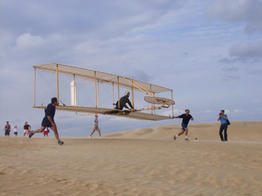
As the launchers run the glider into the wind, the pilot adjusts the
elevator so the nose of the aircraft is neither rising or falling.
The pilot is Lt. Commander Klaus Ohman, US Navy and an F-16 test
pilot.
|
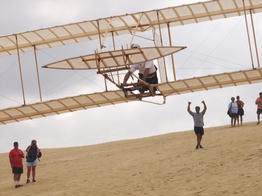
When the pilot feels in control, he calls to the launchers to
"Release!" Lt. Commander Klaus Ohman, pilot.
|

Immediately after release, you must point the nose down and hug the
slope of the dune to gain speed. If you raise the nose too soon, the
glider stalls and settles into the sand, as it is about to do here
for Capt. Jim Alexander, USAF. Jim flies the MC-130 Shadow.
|
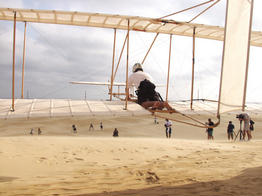
Keep the elevator neutral and the speed builds rapidly as the glider
coasts downhill. Lt. Commander Klaus Ohman, pilot.
|
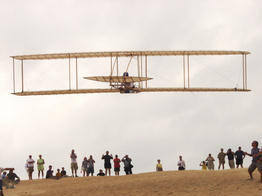
Once you have a little speed, you can trade it for altitude. Capt.
Tanya Markow, pilot.
|

Passing overhead. Capt. Jim Alexander, pilot.
|
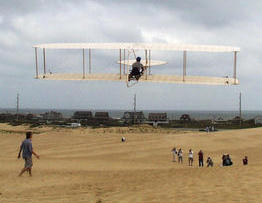
Still on his way up – maximum altitude was 15 to 20 feet. Capt. Jim
Alexander, pilot.
|
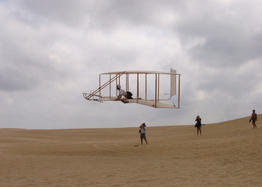
Reaching the bottom of the dune, you raise the nose ever so slightly
to stretch your glide as you lose altitude. Lt. Commander Klaus
Ohman, pilot.
|

While you're in the air, you must keep the wings level and the nose
into the wind. If a wing dips, you must immediately raise it or the
glider will turn at an angle to the winds. Dudley Mead, pilot.
|

The left wing has dipped and Capt. Alexander has thrown his hips to
the right, moving the hip cradle and warping the wings so the left
wing produces more lift than the right.
|
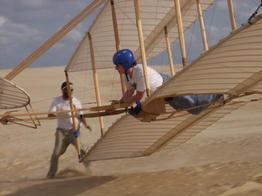
A low wing is especially dangerous close to the ground. Here Major
Dawne Dunlap comes in for a landing with the right wing too low.
|

And here Major Dunlap catches the left wing in the sand. The glider
will pivot on its left wing tip and slam the pilot into the dune.
|
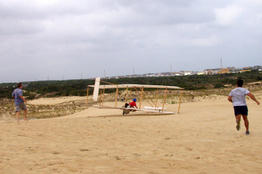
Ideally, the glider should touch the sand with the wings level and
the nose level with the tail. Here the nose is a little low, but
Dudley Mead still pulled off a good landing.
|

Capt. Jim Alexander did not on this run. The nose and the left wing
were a little low and both caught in the sand, pitching Capt.
Alexander out of the cockpit.
|
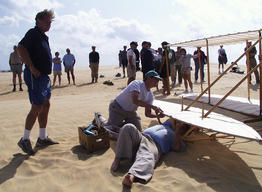
Although it appears fragile, the 1902 glider is survived most of
these hard landings without a scratch. Occasionally something would
break, but we could patch the glider within minutes.
|

Lt. Commander Klaus Ohman makes a perfect landing – or about as
perfect as you can get in the 1902 Wright Glider. The wings, nose,
and tail are dead level, allowing you to scrape your belly in the
sand.
|
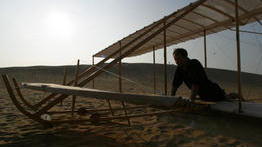
The flights go by so fast, it's hard to learn while you're in the
air. Sometimes after a landing – good or bad – it helps to review
the flight for a moment. Lt. Commander Klaus Ohman, pilot.
|
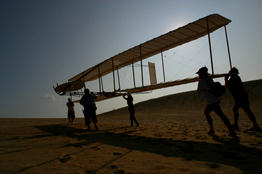
Time to go. The flight crew carries the 1902 Wright Glider back to
our tent/hangar.
|
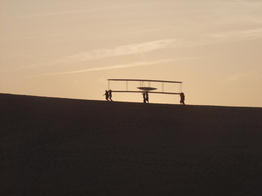
Sunset at Jockey's Ridge.
|
|
|